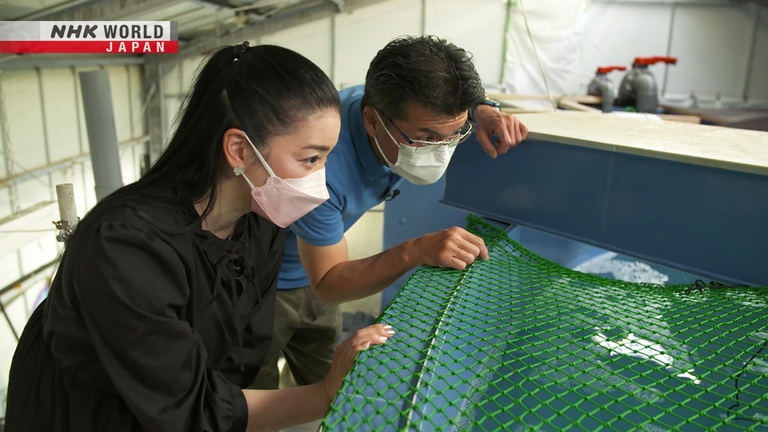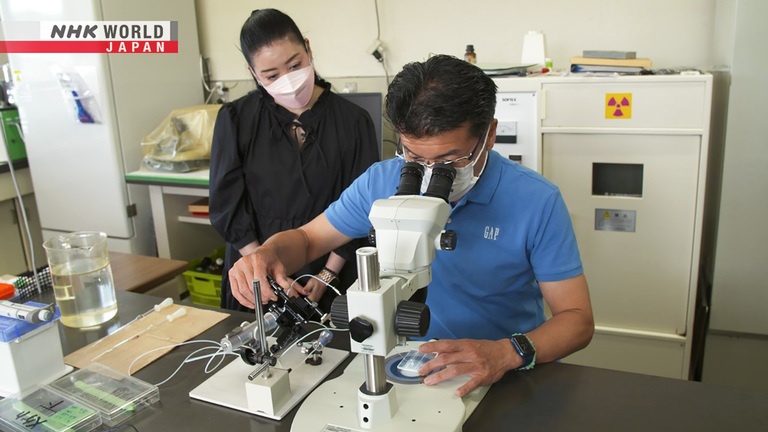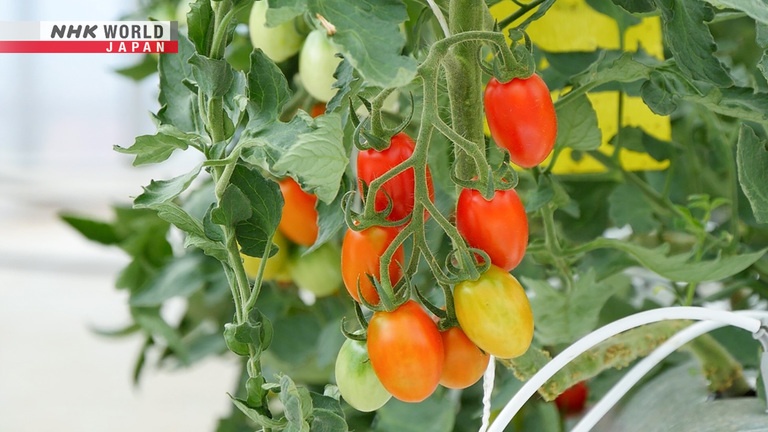Editing Genomes to Improve Food Production
A new genome editing biotechnology can alter genes, known as the "blueprints" of life. Some foods produced with this technology are already on the market in Japan: red sea bream, faster-growing fugu, and tomatoes rich in amino acids said to lower blood pressure. The technology might help solve future food scarcity problems, because it can produce foods with superior properties in less time than with conventional breeding. Many people, however, express concerns about the safety of such food and its impact on the environment. In this episode we look at the latest in genome-edited food research in Japan.




Transcript
Genomes are like the "blueprints" for life.
They determine what characteristics a plant or animal will have.
And nowadays, those blueprints can be read, and even changed...
to trace people's ancestry, create cancer drugs, modify plants, and investigate crimes.
Genetic changes to food are a particularly hot topic.
By editing the genomes, we created
a red sea bream with 20% more meat.
These red sea bream are thicker than normal, with more muscle tissue.
This fugu grows to full size twice as fast.
These tomatoes have five times as much of an ingredient said to lower blood pressure.
These plants and animals have been genetically altered to produce bigger and better foods faster.
The new biotechnology finds and deletes particular genes, creating artificial mutations.
Editing the genomes creates mutations similar
to the random mutations found in nature.
So, this is like a dream technology.
It can very efficiently create improvements.
It's said that editing genomes will make farming more efficient, and could even make inedible plants edible.
It might also help address the food scarcity issues associated with global population growth.
In Japan, approved genome-edited foods first hit the market in 2021.
But some are concerned about the effects of changing nature.
There's no safety review for these foods at all.
Not by the government. Not by a third party.
Could this new technology change what humans eat?
On today's program, we'll get a taste of genetically edited foods.
Hi, I'm Michelle.
I'm in Shirahama town in Wakayama prefecture, a resort town with beautiful sandy white beaches.
In this town, a special fish has been developed using genome editing technology.
Let's go and visit the research site.
Since 1948, the research fishery at this university has studied production techniques for tuna, yellowtail, and red sea bream.
- Professor Kato? Nice to meet you.
- Nice to meet you, too.
Professor Keitaro Kato is a leading aqua-farming expert.
He was the first in the world to grow bluefin tuna from eggs.
He's now trying out genome editing techniques.
You say you've created a better fish.
What exactly is the improvement?
You can see it in this photo.
The fish above is bigger, with more meat.
The fish below is a normal red sea bream.
These fish were fed the same amount of the same food.
But, the genome-edited fish grew 20% more flesh.
Kato showed us where he cultivates the red sea bream eggs he alters.
This is a spawning tank, where we harvest eggs.
There's a window. You can take a look inside.
Oh! I can see them!
The tank contains both male and female fish.
The males have a dark coloring near the front.
First the females release eggs, then the males fertilize them with sperm.
Ah, they've started! There's around 10 males
pursuing a female about to produce eggs.
She releases eggs near the surface of the water.
Then the nearby males release sperm onto them.
That group is moving up.
There it is! She's released the eggs.
They can release up to hundreds of thousands of eggs at a time.
The fertilized eggs are pumped out of the tank and collected in this net.
That pink color. Those are the eggs.
Oh, yes. You can see the coloration.
The fertilized eggs, now embryos, are brought to the genome editing lab.
I put the fish embryos on this plastic plate.
The embryos are less than a centimeter wide.
I put the plate under the microscope
and start the micro-injections.
He treats the embryos using a very thin needle.
They're injected with a special genome editing tool.
It contains substances that automatically disable a particular gene in the embryo's DNA.
How does this simple single injection result in a bigger fish?
Kyoto University Associate Professor, Masato Kinoshita explains.
We suppress the gene that produces a protein
called "myostatin", which regulates muscle growth.
Without the myostatin present,
the fish grow more muscle tissue.
Kinoshita uses a system called "CRISPR-Cas9."
This system makes it possible to edit an organism's genome.
It earned co-developers Emmanuelle Charpentier and Jennifer Doudna the 2020 Nobel Prize in Chemistry.
Every living organism has a distinct "genome," a collection of thousands of genes that determine how it looks and functions.
The CRISPR-Cas9 system can cut the DNA apart at a specified location, destroying the genetic instructions there.
First, guide RNA is used to find the target site in the DNA.
Then, a protein called "Cas9" creates a cut in the DNA there.
When this happens, the cell tries to repair the cut.
But the repair process is prone to errors that disable the targeted gene.
This is how the targeted genes are effectively "knocked out."
In the red sea bream, the target was a gene that produces "myostatin," a substance that regulates muscle growth.
The instructions to produce myostatin are removed from the DNA, so the myostatin isn't produced.
So, the muscle growth isn't limited, and the fish gets bigger.
Myostatin restricts muscle growth in mammals.
We wondered if it had the same effect on fish.
We tested it with medaka, and yes, it does.
And we said, "Great, let's use this to farm fish."
Natural mutations have eliminated the myostatin-producing gene in this breed of muscle-rich cattle known as "Belgian Blue."
Kinoshita used these cattle as a reference when preparing a genome editing tool for the red sea bream.
This type of genome editing aims to replicate mutations that occur in nature, which is considered relatively safer.
Essentially, it removes genetic information.
There is another similar approach, one which adds genetic information.
In this case, rather than cutting genes out of the DNA to eliminate pre-existing traits from the organism, new genes from other species or from research are inserted,
to give the plant or animal new or improved traits or abilities.
Even the experts find genome editing surprisingly effective.
This is truly an amazing technology.
In the early 1960s, Kindai University started
selectively breeding red sea bream.
It used to take 3 years for the fish to reach 1 kg.
Now, it takes less than a year and a half.
Reducing that growth time took us over 20 years.
But with genome editing, increasing
the muscle mass only took 4 years.
It's much faster at producing improvements.
Because this technology can achieve breeding improvements so much faster, it's expected to play a key role in addressing food scarcity issues.
But, some believe that if genome-edited fish mate with natural fish in the ocean or a river, it could have an impact on the ecosystem.
So after they hatch, the genome-edited red sea bream are kept in tanks on land.
And additional features like gutters are used to conscientiously prevent the eggs from escaping the controlled environment.
With the ability to produce larger fish, Kato's team is optimistic about this biotechnology's potential to help solve food security issues.
They're also working on the genomes of other species of fish.
This is fugu, the famously poisonous Japanese delicacy.
These fugu grow twice as quickly, thanks to genome editing.
But how do the enhanced-growth fish actually taste?
Today, a tasting event of genetically edited red sea breem is taking place here.
Let's go and find out!
Well, it looks like ordinary sea breem.
It looks no difference.
Let's see how it tastes like.
It's actually very good.
It's a bit more meatier than ordinary sea breem.
I'm quite surprised.
It's a little more tender than regular red sea bream.
Industrial fishing can be dangerous,
because you're dealing with nature.
And there are long periods with no time off.
If genome editing makes it easier
for us to raise valuable fish, then we could mass produce them as a factory,
like we do with vegetables and chickens.
Then young people could more easily find jobs,
revitalizing the local economy. That's my goal.
We're already starting to see genome-edited foods around us.
They first became available to the Japanese public in 2021.
Initially, they were limited to mail-order purchases of red sea bream, fugu, and tomatoes.
But in July 2022, the first in-store sales of genome-edited foods began at a department store in Tokyo.
This is fugu sashimi.
When it's defrosted, it has a chewy texture.
They sold frozen faster-growing fugu, both for cooking and for sashimi.
They gave out free samples.
This is a fugu with a chewy texture.
It's tasty.
If I clearly explain about the genome editing,
most people admit they like the taste.
Genome-edited foods seem to be making inroads.
What does the person on the street think?
Have you heard of genome-edited foods?
No. It sounds like chemistry food.
It doesn't sound very safe.
It sounds like GMO foods.
But there might be cases where a minus
can be turned into a plus for foods.
I get the strong impression that it's dangerous.
Why do you think it's dangerous?
Well, I'm not sure what "genome" means.
That's a little scary.
For many people, the technology is unfamiliar and its safety suspect.
Before selling food products created by removing genetic information, companies must notify the Japanese government.
But they require no safety reviews or product labeling.
However, food products created by inserting genetic information do require safety reviews and proper labeling.
This is the basic difference between them.
The important point is whether genes
from other organisms are involved.
But this system only deletes pre-existing genes,
as sometimes happens naturally.
In principle, we're only creating things
that could occur in nature.
That's why a safety review isn't needed.
It's no riskier than conventional breeding.
Still, it's new technology,
and we can't leave it go unchecked.
So, we ask that the government be notified
before genome-edited foods are put on the market.
There's no law to enforce that.
It's only a request.
The first three genome-edited foods put on the market in Japan were voluntarily labeled as such.
But some argue that regulations should be more seriously considered before these foods become more commonplace.
These products' safety has never been tested
by the government or any 3rd party organization.
That's a problem. And without regulations,
these products can be sold to people as edible with no indication that they've
been genetically altered.
Consumers rely on labeling when deciding
what to eat and what to avoid.
We're very concerned that the customer's right to
know and right to choose are being violated.
Even if the system only deletes one particular
gene, it could cause unintended other effects.
We must ask Japanese scientists if it's really okay
to put these out into the world as food products.
Consumers need more information about this.
As the debate continues, more and more researchers across Japan are experimenting with genome editing.
Osaka University Professor Toshiya Muranaka is using it on potatoes.
These are field-growing potatoes,
which are less dangerous.
It's generally the greenish parts that are toxic,
like the sprouts that come out.
Conventional approaches haven't
been able to eliminate that toxicity.
We want to tackle that problem with genome editing.
Potatoes contain toxins.
Once harvested, they must be kept in a cool dry place.
For safety, potato processors remove sprouts and large sections of skin.
This results in some edible parts being discarded.
Muranaka's team have identified the gene "SSR2" as being associated with toxin production in potatoes.
Editing the potato's genome to eliminate gene "SSR2" resulted in potatoes with 90% less toxins.
Many plants around the world aren't used for food.
They're edible, but have toxic elements.
We think genome editing can help fix that.
It could also make plants with
medicinal properties more usable.
Possibly even weeds with medicinal properties.
I think it'd be great if we used this technology
to acquire helpful new medicines.
And in Ibaraki prefecture, work is underway on genome-edited plants to make people healthier.
These tomatoes have undergone genome editing.
There's an amino acid we call "GABA" for short.
It helps reduce blood pressure in humans.
These tomatoes contain 5 times as much
GABA as regular tomatoes.
So, we're making GABA-rich tomatoes and hoping
these will help people control their blood pressure.
Among the first genome-edited foods on sale in Japan, these tomatoes are not cheap, 2 kilograms cost around 30 US dollars.
Nevertheless, once these were on the market, requests started flowing in, even from abroad.
A Nagoya University lab is taking a different approach to tomato genome editing.
- Hello. I'm Michelle Yamamoto.
- Hello. I'm Katsuhiro Shiratake.
Associate Professor Katsuhiro Shiratake's tomatoes have drawn attention from a recent international scientific journal article.
What kinds of tomatoes are you growing here?
Sweet tomatoes, long-keeping tomatoes, and
tomatoes with unusual shapes.
This is the sweet tomato that Shiratake's team developed.
It has about 30% higher sugar content.
They disabled an "invertase inhibitor" protein that regulates the migration of sugars from the leaves to the fruit of the plant, making the tomatoes sweeter.
Couldn't you have made sweeter tomatoes
with regular selective breeding?
Why did you choose genome editing?
Conventional selective breeding techniques are
reaching the limits of growing sweeter tomatoes.
Instead, farmers apply less water, which induces
stress, which makes the tomatoes sweeter.
But those sweeter tomatoes are only half the
regular size, and the crop yields are half as much.
Genome editing lets us sidestep those problems.
Our tomatoes and crop yields are normal size.
And these are his current project.
These tomatoes will keep for a long time.
How long do they keep?
We're still experimenting, so I can't say exactly.
But we expect these will last about twice as long.
It is hoped that these tomatoes will help reduce wasted food.
Shiratake is also working on improvements to the CRISPR-Cas9 approach.
The CRISPR-Cas9 approach locates a certain
genetic sequence in the DNA and cuts through it.
The problem is that we don't know
exactly how the cell will mend that cut.
So, we're working with a base replacement
approach developed at Kobe University.
It avoids that problem by rewriting
particular ACGT bases instead of cutting.
We use that to alter the genes.
The techniques for genome editing are evolving rapidly.
What might the future bring?
The first to discover the DNA patterns that led to CRISPR-Cas9 was actually Kyushu University Professor Yoshizumi Ishino.
He shared his thoughts on the future of genome editing.
I think CRISPR-Cas9 and its related technologies
will continue to improve for quite a while.
But I also think that, in the next 20 years or so,
some other technology will surpass it.
When I first discovered these
short repeating sequences in DNA, I had no idea it would lead to the CRISPR
systems everyone is using today.
But the hints were already around me then.
So, I think the hints toward the next system
are already around us now.
To find it, we'll need to stay aware
of all the possibilities.
The ability to target and edit particular genes is a breakthrough technology.
It opens up an entirely new realm for exploration and manipulation.
But it also holds the potential to change our conception of biological life itself.
I hope we'll proceed wisely and cautiously as this technology moves forward.